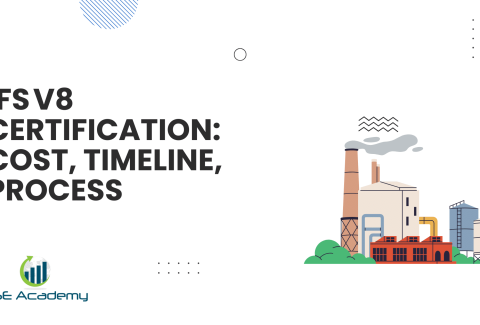IFS V8 Documentation Toolkit: Everything You Need
Last Updated on November 19, 2025 by Melissa Lazaro
Getting Documentation Right for IFS V8
When organizations start preparing for IFS V8, the documentation requirements can quickly feel overwhelming. There are policies, procedures, templates, forms, logs, specifications, and records — and each has a specific purpose. Some companies under-document and struggle during audits because evidence is missing. Others go to the opposite extreme and create hundreds of pages no one reads, understands, or uses.
In my work helping food manufacturers prepare for IFS certification, documentation becomes easier once it’s structured, intentional, and aligned with real operations. A well-designed documentation system gives clarity, supports training, improves consistency, and makes audits manageable rather than stressful.
This guide walks you through exactly what documentation is required for IFS V8 and how to build a controlled, practical, and audit-ready documentation ecosystem.
The Role of Documentation in IFS V8 Compliance
Documentation exists for one purpose: to demonstrate that your food-safety and quality system works in practice. That means records, procedures, and policies must reflect how the site operates — not how someone thinks it should operate.
IFS V8 documentation must show:
- Clear structure
- Version control
- Defined ownership
- Traceability
- Alignment with operational reality
Auditors look for evidence that documents support daily work rather than sit unused in binders or shared drives.
A client once had beautifully formatted documents — but when we walked the floor, no one could explain or follow them. After simplifying wording and aligning procedures with practical workflows, audit confidence improved dramatically. The lesson was simple: a usable document is better than a perfect one no one follows.
 Mandatory Documents Required for IFS V8
Mandatory Documents Required for IFS V8
IFS V8 requires specific documents as the backbone of the food-safety and quality system. These include:
- Quality Manual
- HACCP Plan
- Food Defense and Vulnerability/Food Fraud documentation
- Product-specification files
- Internal audit procedure and records
- Document-control procedure
- Record-retention system
- Training and competency documentation
- Traceability demonstration records
- Supplier approval and monitoring documentation
- Procedures for complaints, recalls, allergen control, and corrective actions
These documents must be controlled, regularly reviewed, and accessible to relevant personnel.
Policies and System-Level Documents
Policies serve as high-level statements of intent. They outline what the organization commits to, rather than how activities are executed.
Typical IFS-mandatory policies include:
- Quality and food-safety policy
- Supplier management policy
- Recall and withdrawal policy
- Regulatory compliance policy
- Allergen-management policy
- Food defense and fraud prevention policy
Strong policies are short, signed by top management, version-controlled, and periodically reviewed.
Procedures and SOPs: Defining How Work Happens
Procedures explain processes step by step. They should be clear enough that trained team members can follow them without guessing.
An effective procedure includes:
- Purpose
- Scope
- Responsibilities
- Defined workflow or step-by-step method
- Monitoring and verification requirements
- Required records
- Revision and approval information
Procedures should match the complexity of the process. If a task takes five steps, document five steps — not twenty.
Forms, Logs, and Records: Evidence of Compliance
Records are proof that tasks were carried out and controls were applied. In IFS, incomplete or inconsistent records often lead to nonconformities — even when the process itself is correct.
Common records include:
- CCP/OPRP monitoring logs
- Cleaning and sanitation verification logs
- Training attendance and competency records
- Equipment calibration logs
- Supplier documentation
- Label verification records
- Complaint and deviation records
- Recall and traceability test documentation
Every record must be:
- Legible
- Signed or authorized
- Dated
- Complete
- Stored securely
Records demonstrate that the system is active — not theoretical.
Templates and Working Tools
Templates make documentation consistent and help ensure critical information is not overlooked. They also speed up onboarding and standardization.
Useful templates include:
- Change-control form
- Risk-assessment worksheet
- Product-specification format
- Mock recall evaluation form
- Label review and verification checklist
- CCP monitoring form
- Supplier approval questionnaire
Templates should remain controlled documents — not editable without authorization.
Document-Control and Version Management
IFS expects documentation to be managed within a formal control system. That means:
- A master document list exists
- Only the latest approved versions are in use
- Obsolete versions are removed from operational areas
- Edits follow a revision workflow
- Documents are stored securely and are accessible when needed
Both digital and paper-based systems are acceptable as long as they meet control requirements. The key is consistency.
Uncontrolled copies, duplicate versions, or process documents saved to personal computers are common audit findings. Assigning document owners prevents this.
Building a Documentation Roadmap
A structured documentation rollout avoids last-minute overwork and confusion. A simple phased approach helps:
Step 1 — Identify mandatory documents
Step 2 — Map existing documentation gaps
Step 3 — Assign ownership and responsibilities
Step 4 — Standardize format and structure
Step 5 — Train teams on usage
Step 6 — Implement internal audits to verify effectiveness
Step 7 — Review, refine, and maintain
Documentation should evolve with the business — not remain static.
Common Documentation Mistakes and How to Avoid Them
Some recurring issues appear across sites preparing for IFS audits:
- Documents are too long or complex
- Procedures don’t match operational reality
- Records are incomplete or missing signatures
- Uncontrolled spreadsheets are used
- Documents are updated but the system isn’t trained
- Revision history is unclear or undocumented
The easiest fix is consistency: simple documents used correctly always outperform extensive documentation no one applies.
FAQs
Do all documents need to be digital?
No. Paper and digital systems are both acceptable if controlled and easily accessible.
How often should documentation be reviewed?
At least annually, and whenever products, equipment, suppliers, or regulations change.
Can we start with templates?
Yes — as long as they are adapted to reflect site-specific processes and risks.
Conclusion: Build a Documentation System That Works for You
IFS V8 documentation isn’t about producing more paperwork — it’s about building a system that creates clarity, consistency, control, and confidence.
Once documentation is structured properly, maintaining compliance becomes routine instead of overwhelming. And during audits, a well-organized documentation system speaks for itself.
If you want the next step, we can move directly into formats, controlled template packs, or a site-specific documentation map — whatever supports implementation efficiently.
Melissa Lavaro is a seasoned ISO consultant and an enthusiastic advocate for quality management standards. With a rich experience in conducting audits and providing consultancy services, Melissa specializes in helping organizations implement and adapt to ISO standards. Her passion for quality management is evident in her hands-on approach and deep understanding of the regulatory frameworks. Melissa’s expertise and energetic commitment make her a sought-after consultant, dedicated to elevating organizational compliance and performance through practical, insightful guidance.








